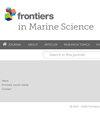Submarine groundwater discharge creates cold‐water refugia that can mitigate exposure of heat stress in nearshore corals
IF 3
2区 生物学
Q1 MARINE & FRESHWATER BIOLOGY
引用次数: 0
Abstract
Coral reef mortality around the world is accelerating due to human activities and rising sea temperatures that cause bleaching, which is expected to become more frequent. Our ability to predict which corals will be most resilient, however, remains limited due to insufficient information characterizing nearshore temperature and habitat conditions. In this study, we examine how submarine groundwater discharge (SGD) reduces nearshore water temperatures and exposure of corals to heat stress, complementing the understanding that SGD can adversely affect coral when it contains elevated nutrient concentrations. Data from fixed nearshore sensors and vertical depth profiles along ~100 km of the western shoreline of the Island of Hawai’i from 2003 to 2014 demonstrate that submarine groundwater discharge (SGD) can reduce nearshore water temperatures by 1 °C–5°C and create estuarine-like conditions with salinities as low as 20 PSU, where the prevalent coral species,海底地下水排放创造了冷水避难所,可以减轻近岸珊瑚的热应激暴露
由于人类活动和海洋温度上升导致白化,世界各地的珊瑚礁死亡率正在加速,预计白化将变得更加频繁。然而,由于缺乏有关近岸温度和栖息地条件的信息,我们预测哪些珊瑚最具弹性的能力仍然有限。在本研究中,我们研究了海底地下水排放(SGD)如何降低近岸水温和珊瑚暴露于热应激,补充了SGD在含有升高的营养物质浓度时可能对珊瑚产生不利影响的理解。从2003年到2014年,来自固定近岸传感器的数据和沿着夏威夷岛西部海岸线约100公里的垂直深度剖面显示,海底地下水排放(SGD)可以使近岸水温降低1°C - 5°C,并创造出盐度低至20 PSU的类似河口的条件,在那里,常见的珊瑚物种poillopora meandrina, Porites lobata和Montipora capitata蓬勃发展。时间序列温度记录显示,暴露于高环境海洋温度(已知会引发白化事件)的时间减少了5%-46%。珊瑚健康调查显示,2010年和2011年,珊瑚白化是对中等高温的反应,更多的珊瑚群受到影响,远离寒冷的、由sgd喂养的水域。综合这些结果,以及2014-2015年更极端的海洋热浪之后的珊瑚响应数据,表明地下水渗漏附近的珊瑚损失更少,珊瑚恢复更快,特别是那些通量更高、对降低近岸水温有影响的地方。我们的研究结果表明,SGD可能因此提供有益的生态系统服务并增强珊瑚礁的恢复能力,特别是在人类相关的地下水营养物质添加可以减轻的情况下。我们的研究结果对加勒比海和印度太平洋等地下水大量流入的热带沿海地区具有重要意义,并有助于提高我们对珊瑚对温度梯度和营养胁迫敏感性的理解。因此,改善地下水资源管理对于缓解未来热应激的地方-区域战略至关重要。
本文章由计算机程序翻译,如有差异,请以英文原文为准。
求助全文
约1分钟内获得全文
求助全文
来源期刊

Frontiers in Marine Science
Agricultural and Biological Sciences-Aquatic Science
CiteScore
5.10
自引率
16.20%
发文量
2443
审稿时长
14 weeks
期刊介绍:
Frontiers in Marine Science publishes rigorously peer-reviewed research that advances our understanding of all aspects of the environment, biology, ecosystem functioning and human interactions with the oceans. Field Chief Editor Carlos M. Duarte at King Abdullah University of Science and Technology Thuwal is supported by an outstanding Editorial Board of international researchers. This multidisciplinary open-access journal is at the forefront of disseminating and communicating scientific knowledge and impactful discoveries to researchers, academics, policy makers and the public worldwide.
With the human population predicted to reach 9 billion people by 2050, it is clear that traditional land resources will not suffice to meet the demand for food or energy, required to support high-quality livelihoods. As a result, the oceans are emerging as a source of untapped assets, with new innovative industries, such as aquaculture, marine biotechnology, marine energy and deep-sea mining growing rapidly under a new era characterized by rapid growth of a blue, ocean-based economy. The sustainability of the blue economy is closely dependent on our knowledge about how to mitigate the impacts of the multiple pressures on the ocean ecosystem associated with the increased scale and diversification of industry operations in the ocean and global human pressures on the environment. Therefore, Frontiers in Marine Science particularly welcomes the communication of research outcomes addressing ocean-based solutions for the emerging challenges, including improved forecasting and observational capacities, understanding biodiversity and ecosystem problems, locally and globally, effective management strategies to maintain ocean health, and an improved capacity to sustainably derive resources from the oceans.
 求助内容:
求助内容: 应助结果提醒方式:
应助结果提醒方式:


